La Vang Holy Land – A well-known destination that should not be overlooked when visiting Quang Tri. As a result of a pilgrimage to this sacred ancient land, visitors include both Catholics and non-religious people. La Vang Holy Land today is a stopover for those who come to see Our Lady pray for benefits or simply to find some peace in life’s heavy pressures. Follow our company, Hanh Huong Vietnam, and we will take you to the La Vang Holy Land, a historical site with a legend that many people still believe in.
I. Where is the La Vang Holy Land?
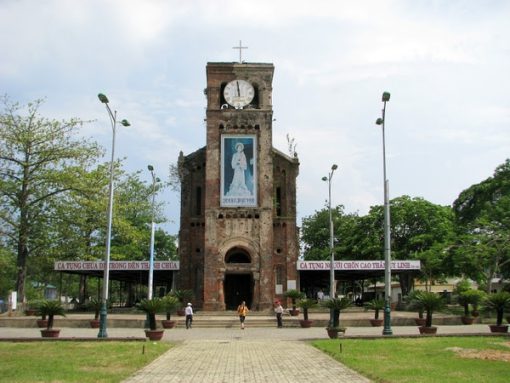
The La Vang Holy Land is located in Phu Hang village, Hai Phu commune, Hai Lang district, Quang Tri province, in the Dinh Cat area (also known as Cat Dinh because Dinh was built on sandy land in the 16th century by Lord Nguyen Hoang). If the distance is not too great, you can reach La Vang Sanctuary by train, bus, or even motorbike from Ho Chi Minh City, Hanoi, and other provinces. The average distance between Hue and La Vang is approximately 54 kilometers, while the distance between Da Nang and Hue is approximately 160 kilometers. You have the option of selecting the appropriate vehicle.
II. Why is it called La Vang?
When it comes to the origins of the La Vang Holy Land, every local will tell you about two stories that are said to be the reason for its name.
In the first legend, foresters were said to be vulnerable to wild animals such as tigers and bewilder if they were careless in the old days when this land was still pristine. As a result, they frequently travel together and alternate nighttime guard duty. They will scream for help when they find the beast. The echoes in the mountains and forests should be enough to call this place La Vang. Simply put, when the laity needs something, it must be shouted because the land is densely forested and the small will not be able to hear if spoken.
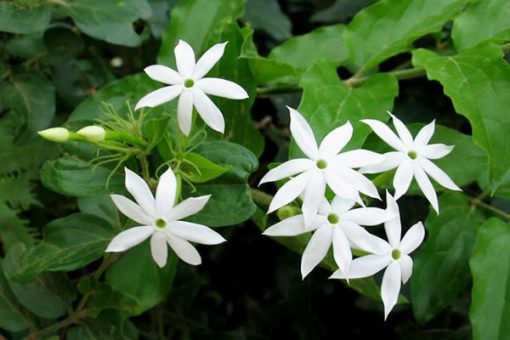
The second legend is more religious, as it is believed that when the epidemic was raging, Our Lady incarnated for the people’s love to show them the medicinal plant known as “leaves” that could cure the disease. After being saved, the people adopted the name of this tree as the name of the land to honor our Lady. Today, the “leaves” dropped the name of La Vang’s holy land. Because this is a very healthy medicinal plant, it is still used to make drinks today.
III. Epiphany relics of Our Lady of La Vang
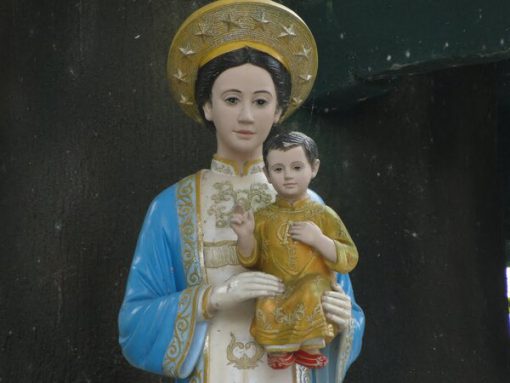
For many Catholics, Lady Mother is grateful for life and grace, and she comes to their aid when they are in need. The Epiphany of Our Lady in 1798 was a historic event.
According to a document in the Roman Catholic Archdiocese of Hue, during King Canh Dinh’s reign (1792–1801), Catholics near Dinh Cat Hill (now known as Quang Tri-Town) were forced to flee to the mountains and forests of La Vang due to the king’s August 17, 1798 ban decree. The forest is very wild at this time, and the conditions are strict. In a critical situation brought on by a severe lack of food and drink in the sacred forest of poisonous water, as well as living day and night in fear of animal attacks and disease, the faithful are only a step away from pleading with God and Lady mother for assistance. Every day, they gathered under the ancient banyan tree to pray for the Epiphany, as well as to console and support one another during the tribulation. They saw the incarnation of the epiphany Virgin Mary with the image of a beautiful woman in a wide robe carrying the Bronze Lord and two angels holding lamps on either side one day while holding Lady’s beads.It is the patron saint of tended to and comforted the laity during their trials and tribulations, and taught them how to select a medicinal plant (leaves) for cooking and drinking water that can cure many diseases. Our Lady appeared for a brief moment before disappearing. Earlier, Lady promised to help anyone who was in danger and to come to her to pray. So the faithful later came to the La Vang Holy Land to pray fervently in the hope that Our Lady would epiphanies and help them. Following the epiphany, Our Lady was said to have appeared several more times to comfort and save her children in distress.
IV. What does La Vang’s Holy Land have?
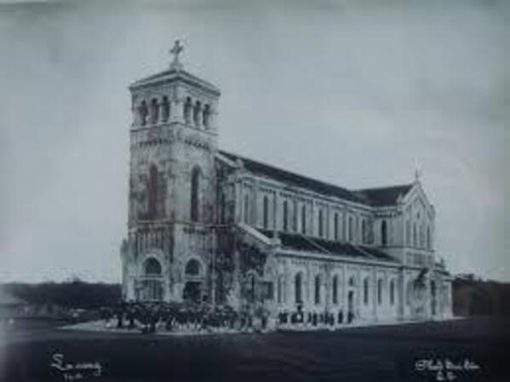
Since Lady of La Vang’s apparitions in 1798, the foundation of an abandoned temple has been given to build a new shrine to honor the Virgin Mary. It was surrounded on four sides by a banyan tree.
The bell-tower architecture of the Lady Mother of La Vang basilica was built in the heart of the sanctuary from 1924 to 1929 and renovated in 1959. By the summer of 1972, the basilica had been almost destroyed by the war, with only the bell tower remaining. The bell tower is still preserved as a historical site and is restored regularly.
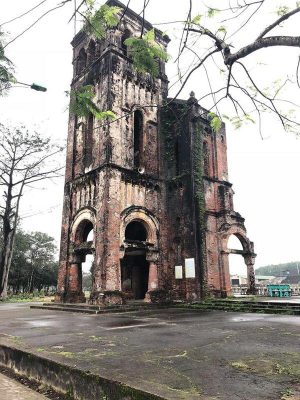
In front of the bell tower is a large square with 14 sculptures of the Cross placed on either side of the square, depicting the milestones in Jesus’ tribulation.
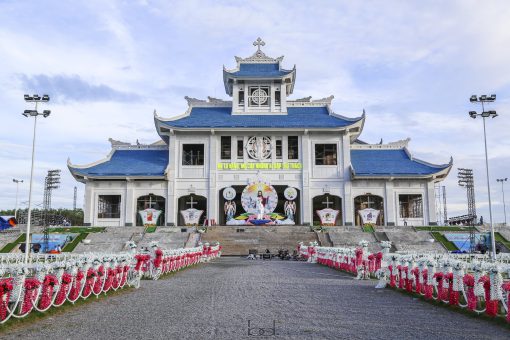
The basilica was later built after the first stone was laid on August 15, 2012. With a capacity of over 5000 people, the cathedral is designed in an Asian style and is considered one of the largest works of the Vietnamese Church.
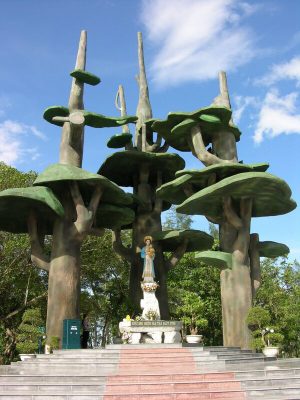
The Lady Statue is revived through the image of a woman wearing traditional Vietnamese garb, holding a baby who is also wearing it. The Lady Statue is now in the Holy Land. The image of Our Lady of La Vang in the middle of three banyan trees, near the base of the ancient one, is thought to be where Our Lady Mother was incarnated in the past.
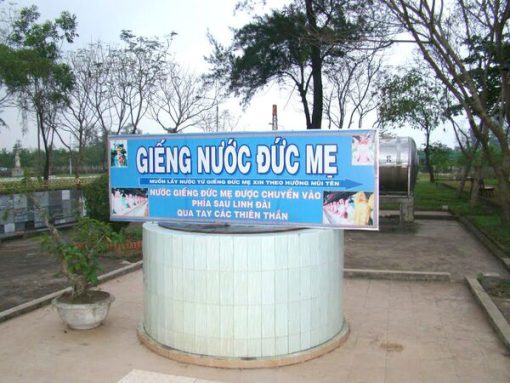
.A well, in particular, can be found on the grounds of the Holy Land of La Vang. People frequently come here to pay their respects to the Lady by taking a sip of water from this well. Many people believe that drinking this water can also cure a variety of diseases in the body.
V. The La Vang Holy Land Pilgrimage Festival (La Vang Palanquin)
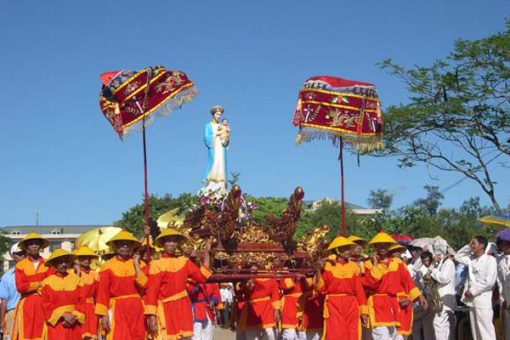
Every year on August 15, people hold “palanquins” as a tradition (pilgrimage festivals). There was a large palanquin called “La Vang Congress” three years ago. The congress began with a solemn ceremony and was attended by hundreds of thousands of parishioners from around the world, as well as many bishops, priests, religious, and hundreds of thousands of parishioners from around the world.
The procession of Our Lady is a special rite performed thoughtfully and solemnly during the Congress to pay homage to Our Lady of La Vang. There was also a night of eucharistic prayer and adoration with her, with the most solemn being the mass honoring the body of Our Lady of the Soul to heaven, which also served as the society’s closing ceremony.
VI. Conclusion
The La Vang Holy Land is not only the greatest religious architecture but also worthy of being a historical relic of the nation.Don’t forget to pay a visit to this one-of-a-kind location. Otherwise, you can still stop here for peace of mind while on bail.
More: Sac Tu Tinh Quang—The famous temple of the Buddhists in the Dang Trong era




Bài viết liên quan: